Explore This Report With These Links
- U.S. Growth Accelerates In Q2
- Fed Cuts Rates As Labor Market Weakens; Policy Path Remains Uncertain
- Labor Market Weakness Warrants Cautious Easing
- Key Inflation Rate Rises To 2.9%
- Consumer Finances Remain Resilient, But Pressures Persist
- Manufacturing And Services Activity
- U.S. Tariff Revenues Hit Record $213 Billion
- Key National Housing Data
- Eurozone Growth Slows But Shows Resilience
- Canada’s Economy Feels The Strain Of Trade Tensions
- China’s Economic Outlook
- Market Commentary
- Market Outlook: Navigating Opportunity And Risk
- Shorter-Term Outlook—Next 12 Months
- Preparing for What Comes Next
Executive Summary
U.S. GDP grew at an annualized 3.8% in Q2, revised up from 3.3%, though trade and inventory swings tied to tariffs distorted the headline figure. Underlying demand strengthened, with real final sales to private domestic purchasers rising 2.9% and personal consumption up 2.5%, led by services. Artificial intelligence (AI)-related investment was the standout driver, as intellectual property and equipment surged, offsetting declines in construction and housing, while the Atlanta Fed projects 3.3% growth for Q3.
The Federal Reserve cut rates by 25 basis points to a 4.0%–4.25% range, framing the move as a “risk management” step to support a softening labor market while inflation remains above target. Updated projections signal two more cuts this year, but fewer in 2026, with future decisions remaining data-dependent amid heightened uncertainty.
The U.S. labor market is weakening more than previously thought, with a preliminary benchmark revision showing 911,000 fewer jobs added through March 2025 and recent monthly gains slowing sharply. August saw just 22,000 new jobs, unemployment ticked up to 4.3%, and small businesses remain especially cautious amid economic uncertainty.
Inflation accelerated in August, with the headline Consumer Price Index (CPI) up 0.4% month over month and 2.9% year over year, while core CPI rose 3.1%. Food, energy, and shelter costs drove the increase, alongside gains in travel, medical services, and core goods. Persistent core pressures, especially in services and housing, complicate the Fed’s policy outlook despite easing from 2022 highs.
U.S. stocks surged to record highs in Q3, with a quarterly return for the S&P 500 of 8.1%, the Russell 2000 gaining 12.4%, and the MSCI EAFE representing developed international markets up 4.8%. Markets have been buoyed by strong AI-related investment, resilient corporate earnings, and expectations of Fed rate cuts. Despite elevated valuations and lingering tariff uncertainty, broad participation beyond mega-cap tech and optimism around monetary easing supported bullish sentiment heading into Q4.
U.S. Growth Accelerates In Q2, Driven By AI Investment And Strong Consumer Spending
Gross domestic product (GDP) rose at a 3.8% annualized rate in the second quarter, revised up from the initial estimate of 3.3%. However, the quarter’s results were significantly skewed by tariff-related volatility in trade and inventories. After a 38% spike in imports in Q1—driven by preemptive stockpiling ahead of the April 2 tariff announcement—imports plunged nearly 30% in Q2. This swing led to a 0.6% contraction in Q1, despite underlying strength.
A key measure of underlying demand—real final sales to private domestic purchasers, which excludes volatile components like trade, inventories, and government spending—rose by a solid 2.9%, up from 1.9% in Q1, signaling stronger consumer momentum. Personal consumption increased 2.5%, with services, which account for nearly half of GDP, accelerating to 2.6%, up sharply from just 0.8% in the previous quarter.
The standout story in Q2 was investment in AI. Intellectual property investment grew 15% and the equipment category grew 8.5%. Information processing equipment contributed 22 basis points to GDP growth, and intellectual property products added 78 basis points. These gains more than offset declines in other areas: construction of structures fell 7.5%, and residential fixed investment (housing) dropped 5.1%, together subtracting 65 basis points from GDP. Transportation equipment was also solid, adding 27 basis points.
Stripping out the noise from trade and inventories, GDP grew at a pace of 1.65% per quarter in the first half of the year—or 3.3% annualized—slower than the 2.5% quarterly average seen in 2024. Looking ahead, the Atlanta Fed’s GDPNow model forecasts 3.8% growth for Q3, with personal consumption expenditures (PCE) expected to rise by 2.7%, suggesting continued resilience in consumer activity.
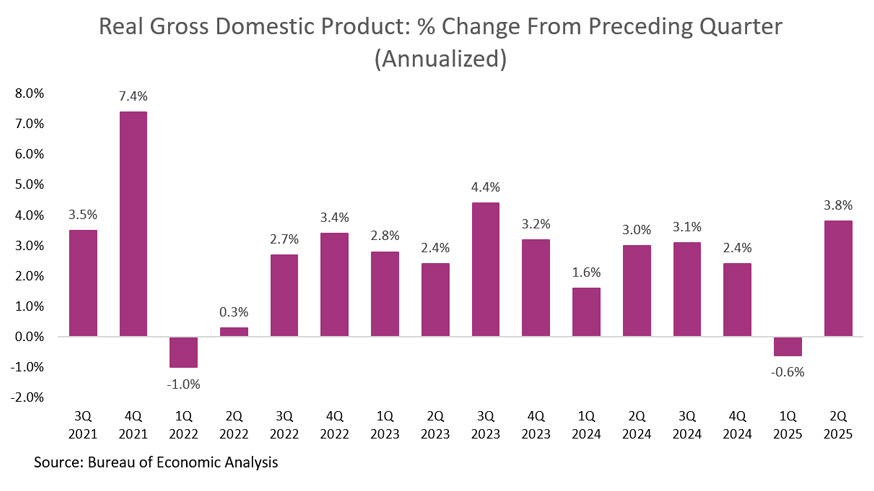
Fed Cuts Rates As Labor Market Weakens; Policy Path Remains Uncertain
As expected, the Federal Reserve cut interest rates by 25 basis points at its September meeting, setting the new target range at 4.0% to 4.25%. Chair Jerome Powell described the move as a “risk management cut,” aimed at supporting a softer labor market while still addressing inflation that remains above the Fed’s 2% target. He characterized the current rate level as modestly restrictive.
The Fed’s updated Summary of Economic Projections signals two additional cuts this year, aligning with market expectations. However, the median forecast for 2026 includes just one rate cut, notably below the market’s pricing of two. The next Federal Open Market Committee meeting is scheduled for October 29.
This shift marks a turning point in monetary policy. For much of the past year, the Fed has been navigating the dual risks of persistent inflation and over-tightening. But recent signs of labor market softness have shifted the balance of risks toward the Fed’s employment mandate, prompting a recalibration toward a more neutral policy stance.
Chair Powell reiterated that future decisions will remain data dependent. Additional rate cuts will be evaluated on a meeting-by-meeting basis, with each economic release—particularly on jobs and inflation—serving as a potential inflection point. This intentional ambiguity is intended to preserve policy flexibility, but it also ensures that markets will remain highly sensitive to incoming data. Complicating matters further, lawmakers failed to reach a deal to avoid a government shutdown on October 1, raising the prospect of delays to key economic data as the Federal Reserve considers its next rate move, adding uncertainty for both the Fed and investors navigating this evolving landscape.
Labor Market Weakness Warrants Cautious Easing
The U.S. labor market is showing deeper signs of weakness than previously understood. According to the Bureau of Labor Statistics’ (BLS) preliminary benchmark revision, 911,000 fewer jobs were added in the 12 months through March 2025 than initially reported—the largest downward revision since at least 2000. Nearly every sector saw downward revisions, underscoring broad-based softness. These revisions reflect discrepancies between two independently compiled employment measures, each subject to distinct sources of error. The initial estimates reported monthly in the Employment Situation Report are meant to be timely and are based on incomplete data. Over time, as more survey responses arrive and census data becomes available, the BLS incorporates this more comprehensive information to improve accuracy. A year earlier, preliminary data suggested an 818,000-job downward revision, later adjusted to -598,000—a pattern that now appears to be repeating, with even greater magnitude.
Recent unemployment data continues to underscore signs of a cooling labor market. In August, the U.S. economy added just 22,000 jobs, while revisions subtracted 27,000 from the prior two months. June’s 13,000 job decline marked the first monthly contraction in employment since December 2020. Year to date, only 598,000 jobs have been added—excluding 2020, this represents the weakest start to a year since 2009, during the aftermath of the financial crisis. The slowdown has been especially pronounced since May, with average monthly gains falling to just 26,750. ADP added to the concern, reporting a 32,000-job drop in private payrolls for September, the largest decline since March 2023.
Due to the government shutdown, the Bureau of Labor Statistics’ Employment Situation Report, originally scheduled for release on Friday, October 3, is expected to be delayed.
Small businesses appear particularly cautious in the current environment. According to the ADP National Employment Report, of the 556,000 private sector jobs added through September, companies with 1–49 employees posted a net reduction of 34,000 jobs, while firms with 50 or more employees accounted for the remaining 590,000. This hiring gap is notable given that 43% of private sector workers are employed by businesses with fewer than 50 employees. The data suggests small businesses are disproportionately impacted by economic uncertainty, rising costs—such as tariffs—and softer demand.
In August, the headline unemployment rate rose to 4.3%, up from 4.2% in July, its highest level since the pandemic, though still well below the 50-year average of 6.1%. The number of unemployed individuals increased by 148,000, reaching 7.384 million, while the labor force expanded modestly by 436,000, lifting the labor force participation rate to 62.8%, up from a two-year low. The August Job Openings and Labor Turnover report showed a slower pace in both hiring and total separations. Job openings totaled 7.23 million, up 19,000 from July but down 422,000 from a year ago.
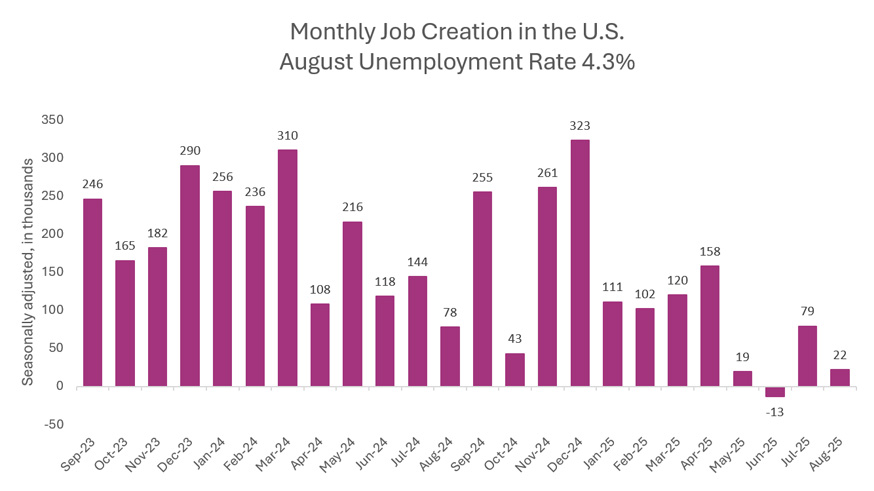
The labor force participation rate measures the percentage of the working-age population (ages 16 and older) that is either employed or actively seeking employment. While overall labor participation rate has declined since the pandemic, it is worth noting that prime-age workers—those between 25 and 54 years old—remain highly engaged in the workforce, with a participation rate of 83.7%, just below the peak of 84.6% set in 1999. Meanwhile, the 55+ age group has grown significantly as a share of the eligible workforce, rising from 12% in the mid-1990s to 23% in 2025. This shift is driven by the aging of the Baby Boomer generation, longer life expectancies, and lower birth rates, all of which are reshaping the demographic composition of the labor force.
Key Inflation Rate Rises To 2.9%
The August CPI report showed a pickup in inflation, underscoring the persistent price pressure that continues to challenge both consumers and policymakers. Headline CPI rose 0.4% month over month, bringing the year-over-year increase to 2.9%. The core CPI, which excludes the more volatile categories of food and energy, climbed 3.1% from a year ago, indicating that underlying inflation remains sticky.
Food and energy drove much of the monthly gain—grocery prices climbed on higher meat, dairy, and produce costs, while gasoline surged on seasonal demand and supply constraints. Core goods rose 0.3%, led by import-heavy categories like apparel and furnishings, while core services—including shelter, medical care, and transportation—also gained 0.3%.
Shelter, the largest CPI component (35.4%), increased 0.4%, remaining a key driver despite some moderation. Travel costs rebounded sharply, with airfares up 5.9%. Medical services and core commodities also showed renewed price momentum.
Taken together, the August CPI report suggests that while headline inflation remains below its 2022 highs, core inflation pressures persist, particularly in services and shelter. This dynamic complicates the Federal Reserve’s policy outlook, as it weighs the need for further rate adjustments against signs of labor market softening and broader economic uncertainty.

Consumer Finances Remain Resilient, But Pressures Persist
On the consumer front, spending remains resilient, though lower-income households continue to feel pressure from elevated prices and borrowing costs. While tariffs present a headwind, broader consumption trends suggest the economy is well positioned to absorb these challenges through year-end.
As of June 2025, U.S. household assets totaled $197.3 trillion, including real estate, investments, savings, and pension funds. Liabilities stood at $21 trillion, with mortgages accounting for approximately 70% of household debt. The household debt service ratio—which measures required debt payments as a share of disposable income—rose to 11.25%, up from 9.7% in 2020 but still well below the pre-Great Recession peak of 15.8% in 2007.
However, signs of financial stress are emerging. Delinquency rates have been trending higher, particularly in student loans, where the end of pandemic-era forbearance has led to a sharp rise in missed payments. As of mid-2025, 12.9% of student loan balances were 90+ days delinquent, the highest in over two decades. This trend is especially pronounced among older borrowers, with 18% of those aged 50+ in serious delinquency.
The University of Michigan Consumer Sentiment Index fell to 55.1 in September, down from 58.1 in August, marking the lowest level since May and a 21.6% decline year over year. The decline was broad-based across age, income, and education groups, with 44% of respondents citing high prices as a key concern. The Conference Board’s consumer confidence index also registered a modest decline in sentiment in September with the “present situation” index hitting the lowest level in a year.
Despite weaker sentiment, retail sales rose a stronger-than-expected 0.6% in August, marking the third consecutive monthly gain. Core retail sales (excluding autos, gas, and building materials) also rose 0.7%, pointing to broad-based strength. The data signals a continued rebound from the spring slowdown, with June, July, and August each rising more than +0.6%. However, concerns remain. Sales are reported in nominal terms, meaning inflation-adjusted growth is closer to 2% annualized. Spending is also uneven: discretionary goods, like furniture remain weak, while online shopping and dining out are strong.
Manufacturing And Services Activity
The S&P Global U.S. Manufacturing Purchasing Managers Index (PMI) eased to 52.0 in September from 53.0 in August, signaling continued expansion but at a slower pace after August’s 39-month high. Output rose for the fourth month, though growth in new orders was marginal amid weaker exports linked to tariffs. Employment gains slowed, inventories grew at a softer pace, and input prices remained among the highest since the pandemic despite a slight dip from August. Firms reported difficulty passing on higher costs due to subdued demand and strong competition. Business confidence improved to a three-month high but stayed below its long-run average.
The Services PMI slipped to 53.9 from 54.5, marking the slowest expansion since June. New orders posted their smallest increase in three months as softer domestic demand offset a rebound in exports. While firms continued hiring, many struggled to fill vacancies. Price pressures persisted, with services reporting the second-highest inflation rate in over two years, though weaker demand expectations limited pricing power. Sentiment rose to its highest since May.
Industrial production edged up 0.1% in August after a 0.4% decline in July, driven by a 2.6% surge in motor vehicle output. Manufacturing output rose 0.2%, but excluding autos, production was flat as utilities fell 2.0%. Year over year, both industrial production and manufacturing were up about 0.9%, suggesting the sector may have found a floor, though momentum remains narrow.
U.S. Tariff Revenues Hit Record $213 Billion
As of late September 2025, the U.S. has collected approximately $213.3 billion in tariff revenues. This marks a historic high and reflects the aggressive expansion of tariff policies under the current administration. The average effective tariff rate has risen to 22.5%, with 30% on Chinese goods and a 10% baseline tariff on most other imports. Steel and aluminum are the most heavily tariffed sector at 41.2%. If proposed tariffs were imposed, pharmaceuticals and movies and media would see a 100% tariff.
To date, however, tariffs have not made a substantial impression on prices. There are several reasons for this: some of the more significant levies only went into force on August 1, and companies had been preparing for their arrival by stockpiling inventories from overseas. These elements serve to defer the consequences. Analysis published by Goldman Sachs found that American importers are absorbing the lion’s share of tariff costs to date. Their behavior may be motivated by a desire to sustain market share, or a hesitance to pass along costs of tariffs which may yet change. But past tariff episodes suggest that this forbearance is only temporary, and consumers will eventually inherit most of the burden.
A majority of the tariffs enacted by the United States in 2025 have been justified by the International Emergency Economic Powers Act (IEEPA). The Trump Administration has contended that persistent and deepening trade deficits constitute an economic emergency, which the IEEPA grants broad latitude to address. A collective of businesses and states filed a challenge to this interpretation in court, which has been upheld at two levels. The Supreme Court will take up the issue in November.
Key National Housing Data
The recent decline in mortgage rates has injected some positive momentum into the U.S. housing market. The Freddie Mac 30-year fixed mortgage rate, which averaged 6.9% to start the year, fell to a three-year low of 6.26% in mid-September.
This drop in rates has already sparked a notable pickup in housing activity. Sales of newly built single-family homes surged 20.5% in August to a seasonally adjusted annual rate of 800,000 units—marking the highest level since January 2022. This figure represents a 15.4% increase compared to August 2024, well above forecasts of 650,000. Meanwhile, the inventory of unsold homes declined 1.4% to 490,000, representing 7.4 months of inventory at the current sales pace—down from 9.0 months in July. Sales of existing homes dipped by 0.2% in August.
Over the last five years, housing values have surged dramatically, far exceeding historical norms. Home values rose around 45% from 2020 to 2025, equating to an average annual increase of 8–9%, nearly double the long-term historical average of 4% per year. This surge was fueled by limited supply and chronic underbuilding, elevated mortgage rates, and rising construction costs. While the 65% of Americans who own their homes have seen substantial gains in wealth, non-homeowners have been increasingly priced out. Rising prices and borrowing costs have made entering the market more difficult than ever. Meanwhile, many existing homeowners are holding onto low-rate mortgages, restricting resale inventory, and creating a stagnant market. Although lower rates should offer some short-term relief, they are unlikely to resolve the deeper structural challenges around affordability and supply.
Eurozone Growth Slows But Shows Resilience
The eurozone economy slowed sharply in Q2 2025 but showed a resilience that suggests a potential rebound in months ahead—despite facing higher U.S. tariffs on exports. According to Eurostat, GDP across the 20 euro area countries rose by just 0.1% quarter over quarter, down from 0.6% in Q1.
While many economists had forecasted a contraction, the eurozone avoided a recession, thanks in part to resilient household spending, which rose 0.1% in Q2. However, falling exports (-0.5%) and a sharp drop in investment (-1.8%) weighed heavily on growth. These dynamics are central to the European Central Bank’s (ECB) cautious stance on rate cuts.
Inflation in the EU held steady at 2.0% from June through August, aligning with the ECB’s medium-term target. At its September meeting, the ECB left interest rates unchanged for the second consecutive time, maintaining the deposit rate at 2.00% and the main refinancing rate at 2.15%.
A recent trade agreement between the U.S. and EU helped ease some uncertainty around tariffs, contributing to a slight improvement in business sentiment. The European Commission’s Economic Sentiment Indicator rose to 95.5 in September, up from 95.3 in August, though still below its long-term average of 100. Consumer confidence also ticked up, but employment expectations declined, reflecting ongoing caution. Meanwhile, real wages have begun to rise as inflation moderates, providing a boost to consumer spending. Unemployment remains near historic lows, and services sectors less exposed to tariffs—such as tourism—are booming. In fact, foreign tourist arrivals to Europe surpassed pre-pandemic levels, with nearly 750 million visitors in 2024 and continued growth in 2025.
Canada’s Economy Feels The Strain Of Trade Tensions
As of 2024, Canada accounted for approximately 12.6% of total U.S. imports, making it one of the United States’ top trading partners—second only to Mexico in overall trade volume.
However, the Canadian economy has begun to feel the strain of escalating trade tensions. Real GDP contracted by 0.4% quarter over quarter in the three months ending in June, as newly implemented tariffs weighed on exports and business investment. This marked a reversal of the frontloaded activity seen earlier in the year.
Labor market conditions have also deteriorated. The economy shed 66,600 jobs in August, following a 41,000-job loss in July, pushing the unemployment rate to 7.1%, the highest level since 2016, excluding the pandemic period.
Despite these setbacks, expansionary fiscal policy, more accommodative monetary conditions, and the recent rollback of Canada’s retaliatory tariffs are expected to support a return to growth in the coming months.
China’s Economic Outlook: Slowing Momentum Amid Structural Challenges and Policy Support
China’s economic outlook as of late September 2025 reflects a slowing but still manageable growth trajectory. The country is on track to meet its full-year GDP growth target of around 5%, thanks to a strong first half of the year, though momentum has clearly weakened in recent months. Manufacturing activity continues to contract, with the official PMI remaining below the 50-point threshold for the sixth consecutive month, signaling ongoing softness in industrial output. The services sector, while more resilient, has also shown signs of slowing, with the non-manufacturing PMI slipping to its lowest level since late 2024.
Domestic demand remains fragile. Consumer prices have fallen, indicating deflationary pressures, and the real estate sector continues to struggle despite targeted policy support. Exports have held up relatively well, providing a buffer to weak internal demand, but new U.S. tariffs and global trade uncertainty pose risks to the external sector going forward.
Policymakers are expected to maintain a supportive stance, with additional fiscal stimulus and interest rate cuts likely before year-end. The upcoming Communist Party plenum in October is expected to outline the next five-year plan, with a focus on transitioning from export-led growth to a more consumption-driven model. While the outlook remains fragile, China’s strong first-half performance, policy flexibility, and export resilience provide some cushion against a deeper slowdown.
Key Rates
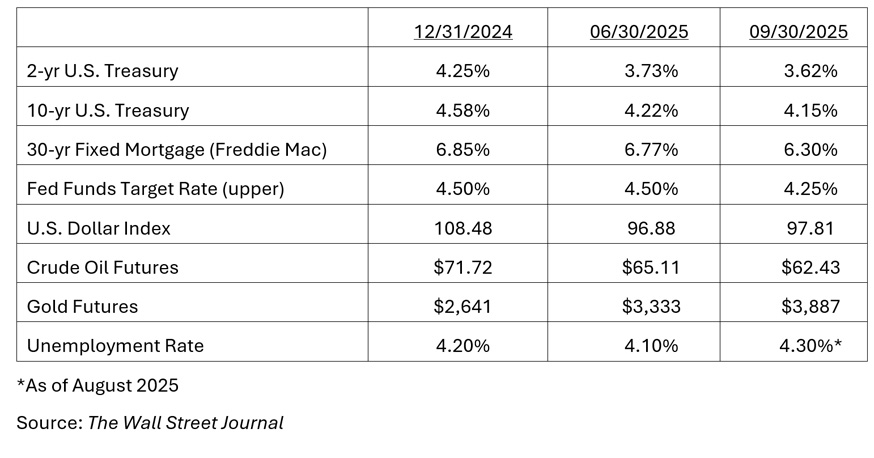
Market Commentary
U.S. equities posted strong gains through the first three quarters of 2025, with the S&P 500 up about 14.8% year-to-date following a 25% surge in 2024. The Nasdaq Composite advanced roughly 17.9%, while the Russell 2000 small-cap index gained about 10.4%, reflecting a more modest recovery in small caps. International markets outperformed: developed markets (MSCI EAFE) rose about 25.1%, and emerging markets gained roughly 27.5%, supported by a weaker U.S. dollar and improving global growth sentiment. The MSCI All-Cap World Index, with a 70/30 U.S.-international mix, climbed about 18.3% year to date.
Mega-cap technology stocks and AI-related investments continued to dominate returns, supported by robust earnings and capital expenditure in data centers and semiconductors. While early-year gains were concentrated in tech, Q3 saw broader participation across sectors as Fed rate cuts boosted sentiment. Over half of the S&P 500’s return came from profit growth, not just multiple expansion, signaling strong fundamentals rather than a speculative bubble. Elevated valuations, tariff-related uncertainty, and slowing labor market trends introduced volatility, but optimism around monetary easing and resilient consumer spending kept markets buoyant.
Growth stocks continued to outperform value across all size categories in 2025, extending a decade-long trend. Over the past 10 years, growth has delivered 19% annualized returns vs. 10.9% for value, though the gap is narrower in small caps (10.1% vs. 9.3%).
For Q3, communication services (+12.6%) and technology (+12.2%) led, while consumer staples (-2.6%) and healthcare (+1.3%) lagged. Year to date, communication services (+25.1%) and technology (+21.3%) remain top performers, with industrials and utilities also outpacing the S&P 500. Healthcare and consumer staples are the weakest sectors.
The Magnificent Seven (NVIDIA, Microsoft, Alphabet, Apple, Amazon, Meta, and Tesla) delivered a combined 18% price return year to date, accounting for roughly 45% of the S&P 500’s gain. NVIDIA, Microsoft, Meta, and Alphabet were among the S&P 500’s top contributors, reflecting continued strength in AI and cloud computing.
All of this robust performance has, though, created some significant valuation issues. The S&P 500 is selling at a forward price-to-earnings ratio of 22.6 times, well above its 20-year average of 19.7. It should be stressed that valuation issues are not pervasive across all capital markets. While no sector of U.S. equity markets looks cheap relative to history, neither value stocks nor small and mid-size stocks look as expensive as large-cap growth.
2025 has been another great year so far for diversified portfolios. Through Q3, the MSCI All-Cap World Index achieved a total return of 18.3% while the Bloomberg U.S. Aggregate Bond Index returned 6.1%, combining to provide a total return on a simple 60/40 portfolio of around 13%. This follows gains of 15% and 11% from the same portfolio over the prior two years.
Global markets have delivered strong gains in 2025, supported by attractive valuations, a weaker U.S. dollar, and fiscal tailwinds despite ongoing trade tensions. The MSCI EAFE Index is up 13.8% in local currency terms, but for U.S. investors, returns are even stronger at 25.1% thanks to dollar depreciation. Emerging markets have also surged, gaining 27.5% year to date with minimal currency impact. These results underscore the value of global diversification and its positive contribution to portfolio performance.
As reflected in the chart below, short-term U.S. Treasury yields have declined as the Fed initiated its rate-cutting cycle, while yields on the long end of the curve remain elevated due to inflation and fiscal concerns.
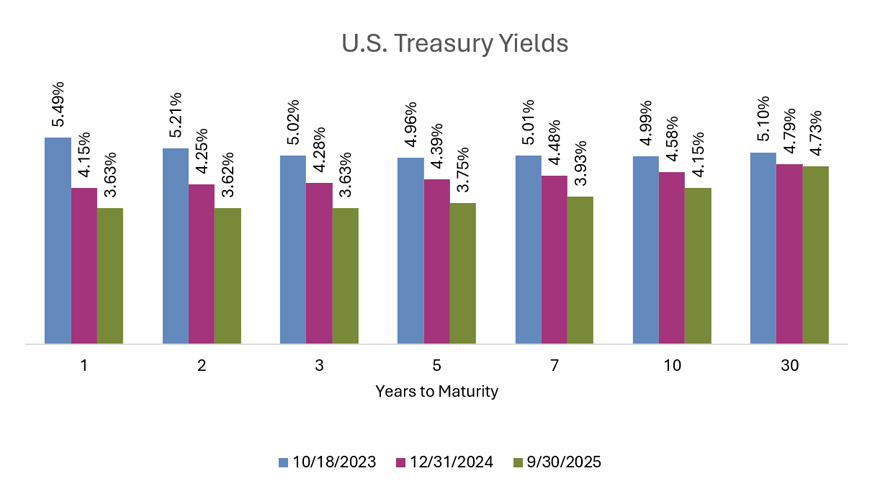
In the fixed income markets, the third quarter of 2025 saw a significant shift lower on the short end of the yield curve as the Fed initiated the rate cutting cycle with a 25-basis point cut. Short-dated bonds more than reflected this cut with a decline in yield of 36 basis points this year. In contrast, the 10-year Treasury yield experienced a modest decrease of 7 basis points, ending the quarter at 4.15%, indicating a mixed sentiment on long-term economic prospects. At the very long end of the curve, the 30-year Treasury yield stayed put with only a 2-basis point decline in rate, pricing in potential higher inflation and increased fiscal deficits, signaling market concerns over long-term fiscal sustainability. For the year to date, the 2-year yield is down 0.63%, and the 10-year declined by 0.43%. Higher income levels and modest yield declines produced a positive year-to-date return of 6.2% for the Bloomberg Aggregate Bond index.
Selected Period Returns
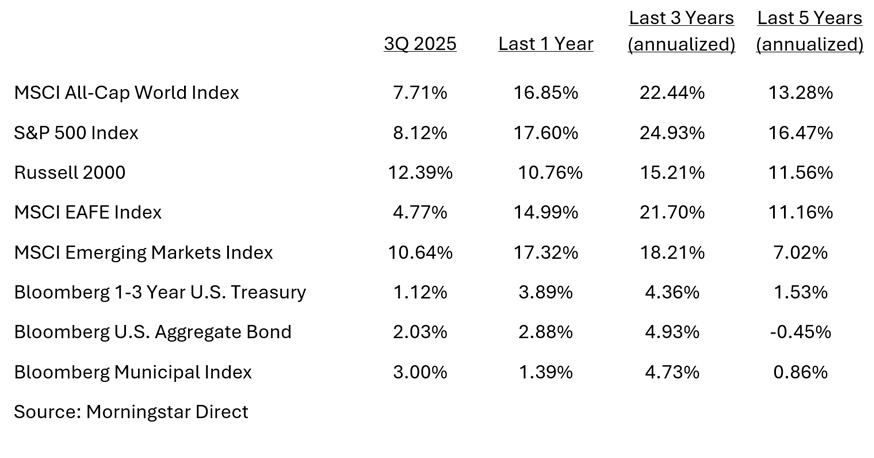
Market Outlook: Navigating Opportunity And Risk
At First Business Bank, our FOLIObuilder™ approach is central to how we manage portfolios. By combining a long-term perspective on capital markets with a clear assessment of shorter-term risks, our disciplined and agile strategy ensures client priorities remain at the forefront as we navigate today’s evolving market environment.
As we enter the final quarter of 2025, markets are balancing optimism with caution. Equity valuations remain elevated after a strong year-to-date rally, while economic data signals a gradual slowdown. Against this backdrop, investor sentiment is anchored by expectations of a soft landing, resilient earnings, and continued AI-driven investment—though these assumptions leave little room for disappointment.
Within First Business Bank’s Private Wealth group, our investment team is balancing long-term capital market expectations with the potential impact of near-term events that could drive volatility. Striking this balance is both an art and a science, requiring discipline, adaptability, and a clear focus on client objectives.
Shorter-Term Outlook—Next 12 Months
The market narrative centers on moderating inflation, steady growth, robust AI-related capital spending, and expected Federal Reserve rate cuts. While equities may continue grinding higher, risks remain. Upside inflation surprises, weakening employment or consumer data, or cracks in the AI story could quickly shift market sentiment. Following the tariff announcements in April, markets experienced rapid repricing and uncertainty. The subsequent correction enabled our FOLIObalancer™ system to trigger a disciplined portfolio rebalance for non-taxable portfolios in early April, reallocating assets near market lows. As equities have rallied strongly and become more overweight in many client portfolios, our FOLIObalancer™ is once again approaching rebalancing triggers—a disciplined process designed to restore balance and manage risk as relative valuations shift. After a nearly 20% drawdown, the S&P 500 has rebounded to new highs, showing resilience amid shifting economic and geopolitical conditions. The sustainability of this expansion hinges on how quickly and effectively the Federal Reserve eases monetary policy to cushion slower growth, whether AI-related capital spending produces lasting productivity gains, and the impact of renewed tariffs and trade frictions on inflation and profit margins.
Continued market gains depend on strong corporate earnings, persistent momentum in AI-driven sectors, and supportive fiscal and monetary policies. At the same time, gradual economic slowing and ongoing tariff risks create important challenges that require vigilance.
Preparing for What Comes Next
First Business Bank’s Private Wealth team works proactively with clients to regularly review portfolios and refine strategies, ensuring each plan aligns with both near-term needs and long-term goals. Our team actively monitors market trends, tax implications, and personal circumstances to identify timely opportunities and address evolving risks. Connect with your First Business Bank Advisors to position your portfolio for 2026 and beyond—our team is ready to help you navigate change and seize future opportunities. First Business Bank – Ready When You Are.
Updated: 10/2/2025





